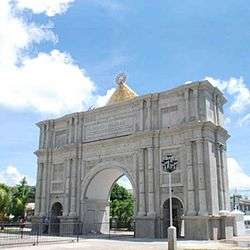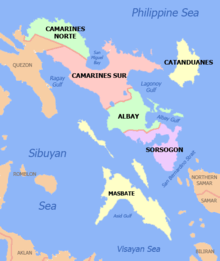Calabanga
Calabanga, officially the Municipality of Calabanga (Central Bicolano: Banwaan kan Calabanga; Tagalog: Bayan ng Calabanga), is a 1st class municipality in the province of Camarines Sur, Philippines. According to the 2015 census, it has a population of 83,033 people.[3]
Calabanga | |
|---|---|
| Municipality of Calabanga | |
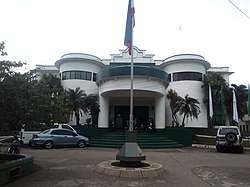 Municipal Hall | |
| Nickname(s): The True Heart of CamSur | |
| Motto(s): Saro sa Pagtubod, Saro sa Pag-asenso! | |
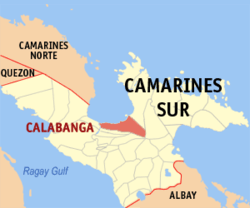 Map of Camarines Sur with Calabanga highlighted | |
OpenStreetMap 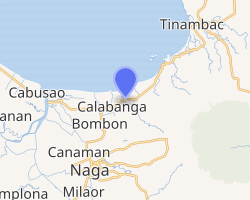
| |
.svg.png) Calabanga Location within the Philippines | |
| Coordinates: 13°43′N 123°14′E | |
| Country | |
| Region | Bicol Region (Region V) |
| Province | Camarines Sur |
| District | 3rd district |
| Founded | 1578 (Quipayo) 1756 (Calabanga) |
| Barangays | 48 (see Barangays) |
| Government | |
| • Type | Sangguniang Bayan |
| • Mayor | Eduardo A. Severo |
| • Vice Mayor | Victor B. De Villa |
| • Congressman | Gabriel H. Bordado Jr. |
| • Electorate | 51,850 voters (2019) |
| Area | |
| • Total | 163.80 km2 (63.24 sq mi) |
| Population (2015 census)[3] | |
| • Total | 83,033 |
| • Density | 510/km2 (1,300/sq mi) |
| • Households | 17,035 |
| Economy | |
| • Income class | 1st municipal income class |
| • Poverty incidence | 36.45% (2015)[4] |
| • Revenue (₱) | 170,265,111.69 (2016) |
| Time zone | UTC+8 (PST) |
| ZIP code | 4405 |
| PSGC | |
| IDD : area code | +63 (0)54 |
| Climate type | tropical rainforest climate |
| Native languages | Central Bikol Inagta Partido Tagalog |
| Website | www |
It has a land area of 16,380 hectares (40,500 acres), which constitutes 3.1% of the Camarines Sur's land area.
Geography
It is bounded on the west by the Bicol River and beyond the municipality of Cabusao; on the south by the municipality of Bombon and Naga City; on the east by the forest lands of Mount Isarog, the Tigman River and each tributary forming the natural boundary and beyond the municipality of Tinambac; on the north by the fishing grounds of San Miguel Bay, and beyond, the municipalities of Sipocot, Basud and Mercedes.
Topography and slope
The topographic landscape of the municipality could be characterized as generally flat with a slope 0-3%, gently sloping (3-8%) towards the direction of the eastern portion and finally rolling up to higher steeps towards the direction of the south-eastern part going to Mt. Isarog. The 0-3% slope is a broad area of flat to nearly level land which extends from Barangay Balongay along the Bicol River to Poblacion area and surrounding areas down to Barangay Manguiring. This is the dominant slope of the municipality.
Soil and water resources
There are six (6) soil types that could be found in the Municipality. These are the (1) Hydrosol which is dominant along the Bicol River covering parts of Barangays Balongay, San Bernardino and Punta Tarawal; (2) Balong Clay; (3) Pili Clay Loam; (4) Tigaon Clay which covers the poblacion; (5) Annan Clay Loam which could be found toward the direction of Tinambac and (6) Mountain Soil in the Mt. Isarog area.
The municipality of Calabanga is endowed with abundant natural resources. The major river systems, the Tigman, Hinaguianan and Inarihan rivers are presently utilized for irrigation purposes. They originate their main tributaries from Mt. Isarog and flow down in the north-western direction ultimately discharging the flow to San Miguel Bay.
Calabanga is blessed with many natural spring water resources found in the eastern portion of the municipality along the north-western flanks of Mt. Isarog. Most of these are found to be potential sources for potable water supply of the municipality, aside from the Hamislag and Tawang rivers.
Calabanga is bounded by water bodies, the San Miguel Bay on the northern part and the Bikol River on the western part which are sources of abundant supplies of fish of various species and other marine products.
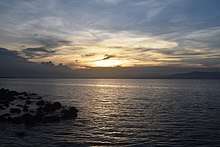
Land use
With its generally flat terrain, the dominant land use is agricultural. The built-up areas and major rivers have the smallest portion of the total area. Built-up areas are clustered within the urban barangays. The urban areas expand in an almost linear development or ribbon like development pattern.
Proposed land use as embodied in the Comprehensive Land use Plan has delineated the Residential, Commercial, institutional area within the Urban Land Use while the agricultural, agro-industrial, special use could be found in the General land use.
Barangays
Calabanga is politically subdivided into 48 barangays, fourteen (14) of which are within the urban area while the remaining 34 barangays belong to the rural areas. It has 11 coastal barangays.
- Balatasan
- Balombon
- Balongay
- Belen
- Bigaas
- Binanuaanan Grande
- Binanuaanan Pequeño
- Binaliw
- Bonot-Santa Rosa
- Burabod
- Cabanbanan
- Cagsao
- Camuning
- Comaguingking
- Del Carmen
- Dominorog
- Fabrica
- Harubay
- La Purisima (Quipayo)
- Lugsad
- Manguiring
- Pagatpat
- Paolbo
- Pinada
- Punta Tarawal
- Quinale
- Sabang
- Salvacion-Baybay
- San Antonio Poblacion
- San Antonio (Quipayo)
- San Bernardino
- San Francisco
- San Isidro
- San Lucas
- San Miguel
- San Pablo
- San Roque
- San Vicente
- Santa Cruz Poblacion
- Santa Cruz (Quipayo)
- Santa Isabel
- Santa Salud
- Santo Domingo
- Santo Niño (Quipayo)
- Siba-o
- Sibobo
- Sogod
- Tomagodtod
- Talacop
Climate
| Climate data for Calabanga, Camarines Sur | |||||||||||||
|---|---|---|---|---|---|---|---|---|---|---|---|---|---|
| Month | Jan | Feb | Mar | Apr | May | Jun | Jul | Aug | Sep | Oct | Nov | Dec | Year |
| Average high °C (°F) | 32 (90) |
31 (88) |
34 (93) |
36 (97) |
37 (99) |
37 (99) |
36 (97) |
34 (93) |
35 (95) |
34 (93) |
33 (91) |
32 (90) |
34 (94) |
| Average low °C (°F) | 27 (81) |
27 (81) |
29 (84) |
31 (88) |
32 (90) |
32 (90) |
31 (88) |
30 (86) |
30 (86) |
29 (84) |
28 (82) |
28 (82) |
30 (85) |
| Average precipitation mm (inches) | 39.34 (1.55) |
68.7 (2.70) |
26.73 (1.05) |
66.19 (2.61) |
84.49 (3.33) |
178.89 (7.04) |
244.27 (9.62) |
188.3 (7.41) |
160.98 (6.34) |
445 (17.5) |
135.5 (5.33) |
367.8 (14.48) |
2,006.19 (78.96) |
| Average rainy days | 16 | 18 | 13 | 15 | 23 | 28 | 30 | 24 | 26 | 27 | 25 | 29 | 274 |
| Source: World Weather Online (Use with caution: this is modeled/calculated data, not measured locally.) [5] | |||||||||||||
History
In 1578 when the head Mission of Quipayo was established, Calabanga was only a visita or barrio. At that time, the place had vast forests and swamps and an abundance of wildlife such as monkeys, wild chickens, and forest lizard. Others say, it derived its name from the Bicol word “Calabangan”, the plural term of “labang” or “litag”, meaning a kind of snare for catching wild animals. Another legend says that Calabanga originated from the word “Calagbangan” meaning the wide, long, and straight street spanning from the church through the poblacion, east to west, called locally as “calabaan” or “calacbangan”.
Calabanga became known with 400 tributes. On July 15, 1749, it was separated from Quipayo by virtue of the approval of Don Fray Joan de Arechera, Bishop Elect of Nueva Segovia of the Commissary of the King, in the petition signed & filed by 37 Calabangueños on April 28, 1749 for town to be conveniently administered.
There were 2 visitas, visita de Cagapad and visita de hinarijan and 12 barrios. The barrios were san Antonio, San Vicente, Santa Catalina, Nuestra Señora de Salud, San Lucas, San Miguel, Santa Isabel, Nuestra Señora del Carmen, San Roque, San Pablo, San Jose (now Balongay) and Belen.
Calabanga is one of the municipalities of the province of Camarines Sur and a member of the Metro Naga Development Council. With its fishing grounds and the vast agricultural area, it is a major supplier of fish and other marine products and prime agricultural products in the province as well as in Metro Manila.
Demographics
|
| |||||||||||||||||||||||||||||||||||||||||||||
| Source: Philippine Statistics Authority[3][6][7][8] | ||||||||||||||||||||||||||||||||||||||||||||||
In the 2015 census, the population of Calabanga was 83,033 people,[3] with a density of 510 inhabitants per square kilometre or 1,300 inhabitants per square mile.
In the 2000 NCSO Survey, Calabanga had a total population of 67,408 with 25,159 or 37.32% belong to the urban population and 42,249 or 62.68% belong to the rural population. There was an increase of 8,244 over the 1995 population. The total population is distributed over 12,444 households, registering an increase of 1,371 households over the 1995 household of 11,073. The average household size in 2000 survey slightly goes up to 5.4 from 5.3 persons in 1995.
Between 1995 and 2000, Calabanga grew at the rate of 2.83%, higher than the 1990-1995 rate of 1.63%. As per the 2010 census, the municipal population density is 477 persons per km².
Of the 48 barangays in the municipality, Barangay San Roque has the largest population of 5,513 people, composing 7.38% of the total population, followed by Barangay Santa Cruz Ratay with a population of 5,069 people. Barangay Punta Tarawal has the lowest population of 265 which only 0.44% of the total population.[6]
Despite the influx of various religious groups, a large segment which is 95.28% of the populace is still Roman Catholics. Most of the populace, 95.93% are Bicolano speaking.
Isarog Agta language
In 2010, UNESCO released its 3rd world volume of Endangered Languages in the World, where 3 critically endangered languages were in the Philippines. One of these languages in the Isarog Agta language which has an estimated speaker of 5 people in the year 2000. The language was classified as Critically Endangered, meaning the youngest speakers are grandparents and older, and they speak the language partially and infrequently and hardly pass the language to their children and grandchildren anymore. If the remaining 150 people do not pass their native language to the next generation of Isarog Agta people, their indigenous language will be extinct within a period of 1 to 2 decades.
The Isarog Agta people live within the circumference of Mount Isarog, though only 5 of them still know their indigenous language. They are one of the original Negrito settlers in the entire Philippines. They belong to the Aeta people classification, but have distinct language and belief systems unique to their own culture and heritage.
Economy
Calabanga is blessed with rich natural resources. It has big uplands and vast fishing grounds. Agricultural areas are the most extensive areas covering more than half of the total land area in this municipality. It is the dominant land use. Land devoted to crop production is approximately 7,609.79 has. Which include rice, corn and coconut as the major crops and other crops such as abaca, coffee, vegetables, rootcrops and fruit trees.
Side by side with agriculture, fishing and livestock raising constitutes major economic activities. The fish grounds of San Miguel Bay as well as the Bikol River are the rich sources of plentiful fish, shellfish, oysters, capiz shells, prawns, shrimps and other marine species providing various livelihood industries such as fish processing, fish paste and bagoong making and other marine by-product. These marine by-products as well as shrimps, prawn, mudcrabs are supplied to the city of Naga, other neighboring provinces as well as in Manila. Other water sources include Inarihan, Tigman and Hinaguinan river aside from the fishponds for the brackish and freshwater species.
Livestock raising is a thriving industry in the municipality, an inventory of livestock and poultry farms shows that there are 5 commercial piggery and 3 commercial poultry farms operating in the municipality aside from the backyard animal raising which is very common in rural areas.
Next to agriculture and fishing, commerce, trade and industry are important and significant aspects in the economy of the municipality. Commercial and industrial activities are more concentrated in the urban areas that include among others wholesale and retail trade, minor service centers, transport business, community and personal services, drugstores, agri-supplies, gasoline stations while industrial activities include rice milling, fish processing, bamboo craft, furniture making, garments, metal crafts, ice plant, welding and auto repair shops as well as other small enterprises. Nipa shingle production is also one industry predominant at western barangays where nipa swamps could be found. The products are sold not only within the municipality but to nearby towns and Naga City.
The presence of a new Calabanga Public Market which started operation last 1998 finally resolved the demands for a bigger marketing center, while Cooperatives throughout the municipality are gradually developing its enterprises.
The municipality is home to two malls, the LCC Center Calabanga which is located in the poblacion of the town, and the small Quipayo Community Center.
Infrastructure
Calabanga is endowed with abundant water resources. At present, the main source of local water district for potable water supply is from Balombon spring. Its capacity is 10 lps which is able to serve 18 barangays. The areas being served are San Antonio poblacion, Del Carmen, Sta Isabel, San Miguel, San Vicente, Santa Salud, San Lucas, San Pablo, San Francisco, Sta Cruz Poblacion, Paolbo, Manguiring, Balombon, San Roque, San Isidro, Pagatpat, Sabang and Salvacion Baybay. Most of these are in the poblacion areas and the rest are the barangays traversed by the source from Balombon.
For barangays not reach by the services of the Local Water District (Level III), the sources are shallow wells, deep wells and water peddlers. These serve the daily needs of the household for potable water supply.
All the barangays of the municipality are link by road system. The municipality is easily accessible from the City of Naga, Bicol Region's prime city. Most of the total road networks need improvements and rehabilitation to provide greater access to far- flung barangay residents and facilitate hauling and marketing of farm produce to the poblacion/ marketing centers.
For inter-barangay linkages, tricycles abound that could bring one to various barangay while foot pedalled tricycles/ padyak abound within the poblacion areas. For bus and jeepney parking facilities, there is a privately owned and operated terminal located at San Francisco but the local government has proposed integrated terminal that will be located within the Calabanga Public Market compound that could accommodate almost all jeepneys and tricycles in the municipality.
From Metro Manila, Calabanga is very much accessible via Naga City. First, by a 45-minute plane flight to Naga Airport located at Pili and a car/jeep ride of some 40 minutes to Calabanga. Another choice is a 7–10 hours aircon bus trip direct to Calabanga being provided by three (3) bus lines. The Philippine National Railways (PNR) also provide trips from Manila to Bicol and vice- versa having a station at Naga City, then it takes some 20–30 minutes ride from Naga City to Calabanga. The power supply in the municipality of Calabanga is provided by the NAPOCOR through the Camarines Sur Electric Cooperative II (CASURECO II). At present, all the 48 barangays of the municipality are already served with electricity, however, several sitios of far-flung barangays are still longing for the extension of power lines to their places.
The modern technology on Communications and information has far reached the municipality of Calabanga and has provided the constituents with better access to communication.
Calabanga is being served by private telephone companies, the L.M. United Telephone Company (UNITEL) and the BAYANTEL Company which provides individual connections for those at the urban and outlying barangays. These companies provide local and long-distance calls to Metro Manila or any point in the country or any other place where the system can reach. Year 2002, the cellular mobile phone services within the municipality was improved and expanded through the installation of telecommunication facilities such as the cell site by two private telecommunication companies. The Bureau of Telecommunications, a government operated agency having a Telecom Office stationed in the municipality is providing telegraphic services to the residents of Calabanga while Postal services is provided mainly by the Philippine postal corporation.
Naga City TV relay stations as well as the cable TV stations are tuned-in in the municipality while a local cable TV station and a private; local community television station and a newly opened radio station are based in the municipality. Radio broadcasts from several radio stations in Canaman, and Naga City. Local as well as national newspapers and magazines are available regularly from newsstands and newsboys from Naga City.
Social services
The municipality enjoys the benefits of several support facilities and services to meet the social and economic needs of its populace as follows.
For education, the municipality has a high rate literacy which is attributed to the continuing efforts of the government to make education more accessible to the people. This is being maintained and improved through the 34 public elementary schools located in 32 places and 8 public secondary schools throughout the municipality aside from several private schools offering pre-school, grade school and high school. A college education and technical /vocational courses is being offered by two government-owned institutions the Calabanga Community College (formed under the administration of then Mayor Ruben B. Medroso) and The Central Bicol State University of Agriculture (Calabanga Campus) and privately owned computer schools.
For those who will pursue colleges courses not offered in the municipality of Calabanga, one has to go to colleges and universities in Naga City or in Metro Manila. The health and medical services of the municipality is provided by three (3) physicians, 5 nurses, 18 midwives and 1 dentist from the government sector aside from private medical and dental practitioners. During the term of then Mayor Ruben B. Medroso the LGU introduced the "Oficina sa Barangay" which literally brings the office of the LGU to the remote barangays of Calabanga to conduct Civil Registration as well as Medical and Dental services to the people of Calabanga.
Health facilities available are 15 private clinics (Medical & Dental), 3 Main and Rural Health Centers and 5 Pharmacies.
The number of health personnel is sufficient and beyond standard as to the ratio to the population, however, facilities and equipment are lacking which are compounded with the dilapidated main health center.
With the social welfare services devolved to the LGU as mandated under RA 7160, which is the Local Government Code of 1991, the municipality of Calabanga have assumed the responsibility of implementing the various programs such as the Child and Youth Welfare, Family and Community Organizing, Women's Welfare, Elderly and Disabled persons. Other services include family life education and counseling, Aid to individuals in Crisis Situation and emergency assistance which have the most number of clienteles. The municipality was able to establish and maintain 62-Day Care Centers located at 48 barangays.
For protective services, Barangay Tanod and Lupon Tagapamayapa were organized in every barangay and afforded appropriate training to help in keeping and maintaining peace and order and in setting disputes within and among barangay residents.
For sports and recreation, the municipality has a covered court at the poblacion area wherein the municipal-wide annual competitions for various sports activities such as basketball, volleyball and other sports are held. However, almost all barangays have multi-purpose play areas which are usually being utilized by the residents especially the youth, as volleyball and basketball courts. There is also a municipal park at the center of the poblacion area where people could spend their time and relax.
Calabanga has a quite a number of tourism potentials and attractions. Famous among the scenic beauties are the group of small islets/islands of Kawit, Tanglad, and Cabgan which is a few minutes from the shore. These islands are frequently visited by excursionists particularly during summer but these places need more development. Other places that invite picnickers to its cool and clear water are Tigman, Hinaguianan and Inarihan rivers and private commercial resorts. Historical sites worthy to see is the “Ladrillo” or a brick old church and ruins of Quipayo built sometime in 1578, more than four (4) centuries ago, being the seat of the Catholic mission. Another is the “HINULID”, Santo Entiero shrine at Santa Salud which is an object of Friday devotion and pilgrimage. Thousands of devotees not only from Calabanga but other parts of Bicol Region and the country flock to the shrine during Maundy Thursday and Good Friday.
Education
The literacy rate in the municipality is high at 98.5%. The NSO survey in year 2000 for household population, 5 years old and over in terms of educational attainment, reflects the following; of the total population, 29,555 are in the elementary grade; 15,037 are in high school; only 2,623 or 0.045% of the population has no grade completed. 4, 446 are college under graduates with 1,057 degree holders and 201 with post baccalaureate degrees.
There are 38 public elementary schools in the entire municipality; eight high schools; one vocational and some five private schools that offer pre-school, grade school and high school. College education is being offered by two government- owned institutions, the Calabanga Community College and the Central Bicol State University of Agriculture (formerly : CSSAC - Calabanga Campus and privately owned computer Schools, one of which offer a multi- grade schooling from elementary to college levels (Malayan Computer College).(edited last Dec.3,2009 by Gilbert Caganda).
| Name of School | Address |
|---|---|
| Calabanga Central Division Pilot School | San Francisco Calabanga Camarines Sur |
| Calabanga West Central School | San Francisco Calabanga Camarines Sur |
| Balatasan Elementary School | Balatasan Calabanga Camarines Sur |
| Balombon Elementary School | Balombon Calabanga Camarines Sur |
| Balongay Elementary School | Balongay Calabanga Camarines Sur |
| Binaliw Elementary School | Binaliw Calabanga Camarines Sur |
| Binanuaanan Grande Elementary School | Binanuaanan Grande Calabanga Camarines Sur |
| Binanuanan Pequeño Elementary School | Binanuaanan Pequeño Calabanga Camarines Sur |
| Burabod Elementary School | Burabod Calabanga Camarines Sur |
| Cagsao Elementary School | Cagsao Calabanga Camarines Sur |
| Camuning Elementary School | Camuning Calabanga Camarines Sur |
| Comaguingking Elementary School | Comaguingking Calabanga Camarines Sur |
| Dominorog Elementary School | Dominorog Calabanga Camarines Sur |
| G. Dumalasa Elementary School | Bonot Santa Rosa Calabanga Camarines Sur |
| Fabrica Elementary School | Fabrica Calabanga Camarines Sur |
| Harubay Elementary School | Harubay Calabanga Camarines Sur |
| Hinaguianan Elementary School | Manguiring Calabanga Camarines Sur |
| Ilihan Elementary School | Tomagodtod Calabanga Camarines Sur |
| Lope Guisic Elementary School | Santo Domingo Calabanga, Camarines Sur |
| Lugsad Elementary School | Lugsad Calabanga Camarines Sur |
| Manguiring Elementary School | Manguiring Calabanga Camarines Sur |
| Pagatpat Elementary School | Pagatpat Calabanga Camarines Sur |
| Paolbo-Belen Elementary School | Paolbo Calabanga Camarines Sur |
| Pinada Elementary School | Pinada Calabanga Camarines Sur |
| Punta Tarala Elementary School | Punta Tarawal Calabanga Camarines Sur |
| Quinale Elem. School | Quinale Calabanga Camarines Sur |
| Quipayo Elementary School | La Purisima Calabanga Camarines Sur |
| Ratay Elementary School | Santa Cruz Calabanga Camarines Sur |
| Sabang Elementary School | Sabang Calabanga Camarines Sur |
| Salvacion Baybay Elementary School | Salvacion Baybay Calabanga Camarines Sur |
| Siba-O Elem. School | Siba-O Calabanga Camarines Sur |
| Sibobo Elementary School | Sibobo Calabanga Camarines Sur |
| Santa Cruz Quipayo Elementary School | Santa Cruz Quipayo Calabanga Camarines Sur |
| Taculod Elementary School | San Roque Calabanga Camarines Sur |
| Tomagodtod Elementary School | Tomagodtod Calabanga Camarines Sur |
| Union Elementary School | San Lucas Calabanga Camarines Sur |
| San Bernardino Elementary School | San Bernardino Calabanga Camarines Sur |
| Taculod Elementary School | San Roque Calabanga Camarines Sur |
| Calabanga National High School | Santa Cruz Poblacion Calabanga Camarines Sur |
| Union National High School | Santo Domingo Calabanga Camarines Sur |
| Jose De Villa National High School | Maguiring Calabanga Camarines Sur |
| Medroso - Mendoza High School | Binanuaanan Pequeno, Calabanga Camarines Sur |
| Quipayo High School | San Antonio Quipayo Calabanga Camarines Sur |
| Sabang High School | Sabang Calabanga Camarines Sur |
| West Coast High School | Dominorog Calabanga Camarines Sur |
| Central Bicol State University of Agriculture Laboratory High School Calabanga Campus | Santa Cruz Poblacion Calabanga Camarines Sur |
| Nuestra Seniora De La Salud Family Rural School | Sta Salud Calabanga Camarines Sur |
| Dominican School of Calabanga | San Francisco Calabanga Camarines Sur |
| Inarihan SDA Multi-Grade School | Paolbo Calabanga Camarines Sur |
| Hansel and Gretel Learning School | San Isidro Calabanga Camarines Sur |
| Central Bicol State University of Agriculture | Santa Cruz Calabanga Camarines Sur |
| WorldTech Research Institute | San Antonio Calabanga Camarines Sur |
| Calabanga Community College | Santa Cruz Poblacion Calabanga Camarines Sur |
Local government
Elected officials June 2013 – 2016:
- Mayor: Eduardo Severo
- Vice Mayor: Ramoncito Roco Robles
- Councilors:
- Danilo N. Campil
- Manuel N. Mendoza
- Jude Anthony C. Hilado
- Sonia H. Medroso
- Danilo Bico
- Erma Barrios
- Levi Santa Ana Jr
- Job R. Casida
References
- "Municipality". Quezon City, Philippines: Department of the Interior and Local Government. Retrieved 31 May 2013.
- "Province: Camarines Sur". PSGC Interactive. Quezon City, Philippines: Philippine Statistics Authority. Retrieved 12 November 2016.
- Census of Population (2015). "Region V (Bicol Region)". Total Population by Province, City, Municipality and Barangay. PSA. Retrieved 20 June 2016.
- "PSA releases the 2015 Municipal and City Level Poverty Estimates". Quezon City, Philippines. Retrieved 1 January 2020.
- "Calabanga, Camarines Sur: Average Temperatures and Rainfall". World Weather Online. Retrieved 29 October 2017.
- Census of Population and Housing (2010). "Region V (Bicol Region)". Total Population by Province, City, Municipality and Barangay. NSO. Retrieved 29 June 2016.
- Censuses of Population (1903–2007). "Region V (Bicol Region)". Table 1. Population Enumerated in Various Censuses by Province/Highly Urbanized City: 1903 to 2007. NSO.
- "Province of Camarines Sur". Municipality Population Data. Local Water Utilities Administration Research Division. Retrieved 17 December 2016.
External links
| Wikimedia Commons has media related to Calabanga, Camarines Sur. |
